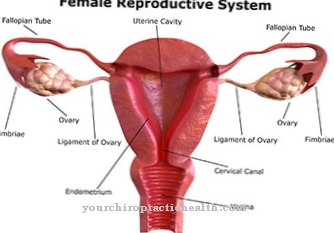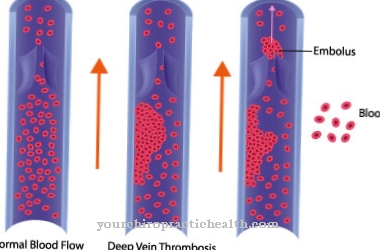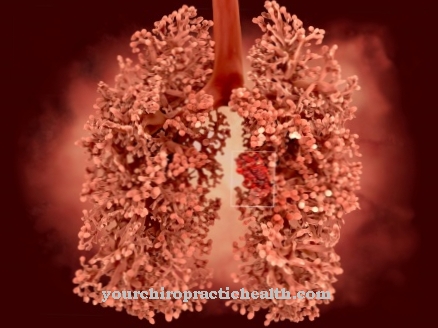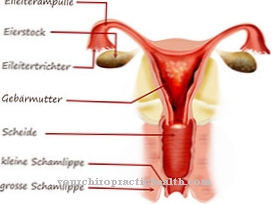The Fluorosis is a disease that can affect different parts of the body. To combat fluorosis, excessive fluoride intake must first be stopped.
What is fluorosis?

© anton_novik - stock.adobe.com
In medicine, the term fluorosis is used to summarize diseases that are due to an oversupply of the human organism with fluorine (a mineral found in bones and teeth, among other things).
The forms of fluorosis include, for example, dental and bone fluorosis (skeletal fluorosis). While dental fluorosis accounts for the most common cases of fluorosis, skeletal fluorosis occurs comparatively rarely. Depending on the severity, dental fluorosis can manifest itself, for example, in brownish-yellowish or chalky-white discoloration of the teeth in places.
The resistance of tooth enamel to tooth decay is reduced in fluorosis, which affects the teeth. In the context of fluorosis, which occurs in the bones, hardening or compaction of bone material can occur, among other things; this causes the affected bones to lose elasticity and become more fragile.
causes
Fluorosis is caused by a long-term excessive intake of fluoride. One of the possible causes of such an oversupply of fluorine is, for example, the long-term intake of drinking water that has a naturally high fluoride saturation. In various countries, fluorine is added to drinking water, which is why an increased incidence of fluorosis is observed in corresponding areas.
Fluorine in the body can also be chronically overdosed through long-term use of fluoride preparations that are highly concentrated. Since various dental care products are also enriched with fluorine, especially in children, fluorosis can occasionally be traced back to frequent swallowing of the corresponding toothpaste while cleaning the teeth.
Symptoms, ailments & signs
Depending on the type of fluorosis, the disease can cause a number of symptoms and complaints. With dental fluorosis, brown to white discolorations and stains appear on the teeth, which increase over time and can ultimately also cause psychological complaints. At first, bone fluorosis does not produce any clear symptoms.
As the disease progresses, the spine becomes stiff and the bones thicken, making the bones and joints more sensitive. Those affected suffer more often bone fractures and are physically less productive overall. Bone fluorosis can cause permanent restrictions of movement as well as wear and tear on joints, poor posture and other complications.
Acute fluoride poisoning leads to nausea and vomiting after a few minutes to hours. They suffer from diarrhea, abdominal pain and occasionally constipation. In the course of the disease, impaired consciousness such as dizziness and failure symptoms can occur.
In addition, cardiovascular complaints arise, which can be expressed, for example, by sweating, palpitations and panic attacks. The symptoms of fluorosis can develop insidiously or occur acutely, always depending on how intensively the person concerned is exposed to the substance. With early treatment, serious complications can be reliably avoided.
Diagnosis & course
Depending on the type of fluorosis, the diagnosis is different; the suspected diagnosis of dental fluorosis can often be made by a dentist based on the symptoms that are typically present.
If there is a suspicion of fluorosis affecting the bones, so-called imaging procedures such as X-rays can provide further diagnostic information: An existing skeletal fluorosis can be recognized on X-rays, for example, due to significant new bone formation, which makes the bones appear completely white. General indications of fluorosis can also be taken from a person's blood count.
If no countermeasures are taken to combat an existing fluorosis, the symptoms usually increase as the disease progresses. While dental fluorosis can show itself in the initial stage, for example, as only minimal discoloration of the teeth, the teeth often take on flat, chalky-white discoloration in later stages; the teeth become increasingly porous and can decompose. Later stages of bone fluorosis can, for example, in some cases lead to limited joint mobility due to the formation of new bone.
Complications
In the worst case scenario, fluorosis can lead to death. However, this case is only achieved if the increased supply of fluorine is not stopped. In most cases, fluorosis stains the teeth. These can be white or brown.
The bones are also less resilient, so the risk of a bone fracture is increased. Fluorosis also includes diarrhea, vomiting, and nausea. The quality of life is reduced by the symptom, heavy physical exertion can no longer be carried out.
If the fluorosis is stopped, the symptoms can regress so that there are no further complications. Since the teeth are also affected by fluorosis, treatment by the dentist is necessary to repair the damage. It is usually possible to restore the teeth or replace them with implants.
This means that there are no further complaints. If the fluorosis occurs acutely due to the increased intake of fluorine, it can lead to death. Therefore, in this case, urgent medical care is necessary. Most often the patient's stomach is flushed out.
When should you go to the doctor?
Acute fluoride poisoning must be treated immediately. For example, if a child has swallowed a whole tube of toothpaste, a visit to the doctor is indicated. Warning signs of poisoning include nausea and vomiting, paleness and diarrhea.
In addition, blood clotting disorders and cardiac arrhythmias can occur, which must also be clarified immediately. Fluorosis does not necessarily have to be treated. Most of the time, the symptoms only affect the teeth and recede as soon as the person concerned changes to another toothpaste or the intake of fluorine tablets is reduced.
If you have a very visible yellowish-brown discoloration, you should definitely go to the dentist. Usually the affected teeth have to be extracted to prevent them from spreading. A doctor's visit is also required if the use of a toothpaste containing fluorine causes further discomfort.
For example, if you have gastrointestinal complaints or headaches you should go to your family doctor, who can determine a possible fluorosis and refer the patient to a dentist. Patients with fluorosis should have regular medical examinations to rule out complications.
Doctors & therapists in your area
Treatment & Therapy
If fluorosis has been diagnosed, it is first important to interrupt the excessive fluorine intake. If this is possible, disease-related changes to the bones can partially regress again.
Which treatment steps follow the regulation of the amount of fluoride supplied in the case of dental fluorosis depends on the tooth damage that has already occurred as a result of the disease. As a rule, one goal in dentistry is to preserve damaged teeth. However, if one or more teeth are severely damaged by the effects of fluorosis, it may be necessary to remove the corresponding teeth or replace them artificially.
So-called acute fluorosis (fluoride poisoning) requires emergency medical care in some cases or can (especially in children) be life-threatening. Acute fluorosis of this kind can occur as a result of ingested (usually unintended) toxic amounts of fluorine. Medical measures for acute fluorosis include rinsing the stomach; ideally, this should be done no later than two hours after ingestion of the fluoride.
Outlook & forecast
In the case of fluorosis, a distinction must be made between the acute and chronic forms. Acute fluorosis, while uncomfortable, is not dangerous in an otherwise healthy adult. Nausea, vomiting, or diarrhea occur and accompanying paresthesia can occur. As soon as the excess fluoride has been excreted, the symptoms disappear again and the patient is soon better. In children, the toxic dose of fluoride is lower, so they can experience worse symptoms than in adults.
Chronic fluorosis has more long-term effects that can be felt on the bones or teeth. In the teeth, excessive supply of fluoride leads to white spots and light, large-area discoloration on the teeth. Depending on the severity, the stained appearance represents an aesthetic problem for the person affected. In addition, the teeth wear out more quickly in the affected areas, as this is a change in the mineral composition of the tooth enamel and it can no longer guarantee adequate protection of the teeth .
When fluorosis affects the bones, certain structures of the bones thicken, making them more prone to fractures and fractures. In addition, the joints can be restricted in their mobility or, in the worst case, cannot be moved at all if they are affected by the thickening caused by the fluorosis.
prevention
Fluorosis can be prevented by controlling the amount of your own fluoride intake (as far as possible). If fluoride preparations are taken for health reasons, it can be sensible (if medically justifiable in the individual case) to avoid a dose that exceeds a daily fluoride amount of 2 milligrams.
Aftercare
The measures or options for follow-up care for fluorosis are very much dependent on the exact cause and the exact symptoms of the fluorosis. For this reason, no general forecast can be given here. First and foremost, however, the disease itself or its underlying disease must be treated, whereby the increased supply of fluoride must first be stopped.
If the fluorosis is poisoning, no further follow-up measures are usually necessary. After detoxification, the person affected should avoid the increased source of fluoride and not take in the increased amount again. It is important to ensure proper nutrition, and a doctor can help.
If the fluorosis causes damage to the teeth, they must be treated properly. As a rule, a dentist should be seen immediately after the detox in order to prevent further complications in the oral cavity. However, if the amount of fluoride is very high, go to a hospital or call an emergency doctor immediately. It cannot generally be predicted whether the disease will lead to a reduced life expectancy.
You can do that yourself
First of all, all sources of fluorine in the household should be checked: toothpaste and table salt sometimes contain very large amounts. Fluoride-free toothpaste and additive-free salt are commercially available. If children are given fluorine tablets as part of dental prophylaxis, their continued use should be discussed with the attending physician.
Since fluorine attacks the calcium reserves in the body, attention should be paid to a diet rich in vital substances and calcium. In this way the body's own depots can be replenished. Dairy products and green vegetables such as broccoli and kale are particularly rich in calcium. Mineral water can also contribute to a good calcium supply.
Existing discoloration on the teeth can be counteracted with coconut oil. This has a lightening and antibacterial effect at the same time. The dentist will always try to preserve diseased teeth. In some cases, however, an exchange with artificial dentures must be made. For acute fluorosis - which often affects children - emergency medical treatment is necessary. In the hospital, the stomach is first pumped out and rinsed in order to contain the poisoning reaction.
Homeopathy offers an alternative to protect teeth from tooth decay without adding fluoride. The agents Calcium fluoratum (D12), Calcium phosphoricum (D6) and Silicea also have a strengthening effect on teeth, gums and oral flora. A balanced acid-base balance is also important, as acidic oral flora attacks the tooth enamel.



.jpg)




















.jpg)



